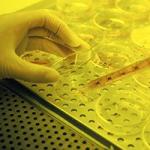
Kenton J. Swartz, Ph.D.
Senior Investigator
Molecular Physiology and Biophysics Section
NINDS
Research Topics
The research focus of the laboratory is to understand how ion channel proteins sense critical biological stimuli, including membrane voltage, temperature and chemical signals. Understanding the structure and mechanisms of voltage-activated ion channels is of fundamental importance because these proteins generate nerve impulses and thereby enable neurons to signal rapidly over long distances. A mechanistic understanding of these proteins is of medical significance because they are involved in many diseases, and are widely targeted by therapeutic drugs. X-ray structures of voltage-activated potassium (Kv) channels in activated/open states have led to new ideas about how interactions between voltage-sensing domains and the lipid membrane may be crucial for the function of these channels. We are exploring this theme using a range of approaches, including using tarantula toxins that bind to voltage-sensing domains within the membrane to investigate the protein-lipid interface and solve the structure of a resting/closed state. We have also discovered a new protein that contains an identifiable S1-S4 voltage-sensing domain and large cytoplasmic termini, which we named Coupled Voltage Sensor (CVS). Our results suggest that CVS is a functional voltage sensor, and we are currently testing the hypothesis that CVS interacts with a intracellular signaling pathways. We also study the mechanism by which transient receptor potential (TRP) channels sense changes in temperature, a mechanism that is critical for their biological roles in thermoregulation and detection of noxious stimuli. Studies with tarantula toxins and regulatory ion binding sites point to a critical role of the external pore in the gating mechanisms of TRPV1, and we are working to localize the temperature sensor and understand its mechanism. Our efforts to understand the structure and operational mechanisms of ligand-activated ion channels involved in intercellular communication has focused on P2X receptor channels, a family of trimeric cation channels that are activated by extracellular ATP. Thus far we have explored the structure and dynamics of the pore, and investigated whether the pore undergoes dilation in response to continual activation. We are currently exploring two distinct mechanisms by which divalent cations differentially regulate P2X receptors, either by binding along with ATP and determining the forms of ATP that serve as agonists, or by binding within an unusual chamber within the large extracellular domain to regulate the process of opening or desensitization.
Biography
Selected Publications
- Fernández-Mariño AI, Tan XF, Bae C, Huffer K, Jiang J, Swartz KJ. Inactivation of the Kv2.1 channel through electromechanical coupling. Nature. 2023;622(7982):410-417.
- Tan XF, Bae C, Stix R, Fernández-Mariño AI, Huffer K, Chang TH, Jiang J, Faraldo-Gómez JD, Swartz KJ. Structure of the Shaker Kv channel and mechanism of slow C-type inactivation. Sci Adv. 2022;8(11):eabm7814.
- Ballesteros A, Swartz KJ. Regulation of membrane homeostasis by TMC1 mechanoelectrical transduction channels is essential for hearing. Sci Adv. 2022;8(31):eabm5550.
- Selvakumar P, Fernández-Mariño AI, Khanra N, He C, Paquette AJ, Wang B, Huang R, Smider VV, Rice WJ, Swartz KJ, Meyerson JR. Structures of the T cell potassium channel Kv1.3 with immunoglobulin modulators. Nat Commun. 2022;13(1):3854.
- Huffer KE, Aleksandrova AA, Jara-Oseguera A, Forrest LR, Swartz KJ. Global alignment and assessment of TRP channel transmembrane domain structures to explore functional mechanisms. Elife. 2020;9.
Related Scientific Focus Areas


Biomedical Engineering and Biophysics
View additional Principal Investigators in Biomedical Engineering and Biophysics


Molecular Biology and Biochemistry
View additional Principal Investigators in Molecular Biology and Biochemistry

This page was last updated on Wednesday, August 28, 2024